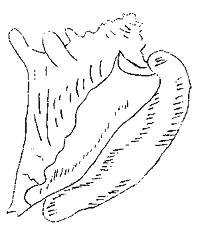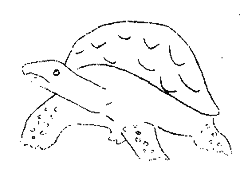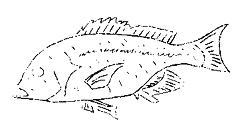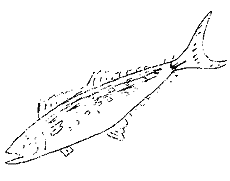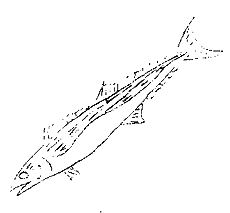|
|
 R.D. AUXILLOU RESEARCH STATION, CAYE CAULKER
The information herein is fairly accurate but still under research and revision, therefore beware of possible inaccuracies. It is not intended to be a perfect listing but just a beginning guide for the interested person in our local commercial fish populations and variations. Click below to refer tothe different species, note that this was written in 1967, and this reflects conditions at that time. 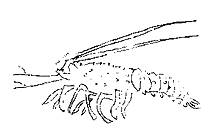
SPINEY LOBSTER - Panulirus argus Present all year round. Most commercially productive time is OCTOBER, NOVEMBER, DECEMBER. Has off season regulation, closed March 15th to July 15th. Also size limit of 4 oz. tail weight. It is the present major marine resource and under crop control investigations for proper economic conservation. The potential is fully developed by locals and utilized 
SHRIMP (Browns and Pinks) Presently restricted exportation until 1972,by foreign firm. Potential is 800,000 lbs. and is a proven resource. White and Royal Red shrimp have also been caught by the experimental Gear Research Station. Present fishery is confined mostly to inner channels in the 10 to 30 fathom range. Heaviest catches from September through February. No local development because of lack of low interest, long term loans and needed technical guidance. 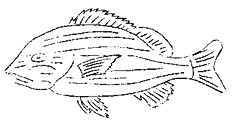
INSHORE REEF AND ROCK SPECIES There are many inshore species too numerous to list but which have a local market potential. Present local market sales come from this group of fish. The production could be tripled with improved gear and if stealing of stationary fishing gear could be eliminated. This fishery represents more than $1 million of foreign exchange savings of food imports. TYPES: Jacks, tarpon, snook, yellowtail, porgy, grunt, bonefish, rockfish, jewfish, barracuda, anglefish, etc., etc. GROUPER - Mycteroperca venenosa Epinephelus mario, Mycteroperca bonaci. Yellowfin grouper, red grouper and black grouper common. They are caught up to 40 lbs. in size. Average 12 lbs. Main spawning season is DECEMBER, JANUARY, FEBRUARY over the full moon. Grouper heavy with roe. Present method is seasonal with hook and line at Caye Glory, Caye Bokel and Gloverās Reef points. Potential is for 300,000 lbs. but better gear methods are needed. It is also fished all year round, in rocks, on a lesser scale. CONCH - Strombus pugilis, Strombus gigas, Cassis madagascariensis, Cassis flammea, Strombus raninus, Cassis tuberosa, Strombus alatus. Found on sandy bottoms. Queen conch, West Indian and Florida fighting conchs, are most predominant commercial species. Beds known to local fishermen and can be easily, fully utilized. All year round fishery. A price of over 17 cents per pound needed for commercial exploitation by local fishermen. TURTLE Loggerhead is the most common commercial species. Loggerhead are caught all year round but most frequently the first half of the year. Turtle nets are the method used. Turtles can run several hundred pounds in weight. They are most often caught outside the reef, over rocky holes in thirty fathoms. LAND CRABS Seem to appear in large quantities during JULY, AUGUST. They travel at night on the land. Smaller quantities are found all year, but not much research done on them
STONE CRABS No organized fishery present but at least one commercially potential area known in the north, by Stone Crab Point and Mosquito Caye. No specialized crab fishing methods known locally and technical assistance would be necessary before it could be developed in any way. Local stone crabs are large and of delicious flavour. RED SNAPPER & YELLOW EYE SNAPPER Large potential proven by commercial trials. Sheltered grounds to the lee of offshore reefs about 800,000 lbs. Total area including exposed reefs about 3,000,000 lbs. Red snapper found from 30 to 75 fathoms. Yellow eyed red snapper found 90 to 175 fathoms. Best commercial area 80 fathoms. Virgin grounds but not higher than average. Not yet commercially exploited by locals. Larger boats of longer waterline required for development and technical guidance also needed. Should definitely be restricted to local exploitation, as it is easy to adapt local methods, economically. MIDGET SILK SNAPPER Spawns on flat shallow, thick grassy areas in JUNE, JULY, AUGUST. Heaviest spawning run, from the last quarter to the new moon, of each month. ø to 1 lb. average size. Present method of fishing, hook and line. Experimental small boat otter trawling has proved successful. Potential for 25 tons per monthly run, or 150,000 lbs for three months. Excellent fish for salt, pickled or brined product for sale in the West Indies. Only local market currently exploited and is easily glutted. RED MUTTON SNAPPER This species of red snapper is reputed to school in February, March, April, particularly around Buttonwood Caye. The snapper averages 12 lbs. in size and is fished in about 18 fathoms of water. It is reputed to occur generally throughout the country at this time, in 18 fathoms depth. No research has been done on this species. Unconfirmed reports indicate a minimum potential of 200,000 lbs. BLACK SNAPPER These travel down the inside reef from North to South in small and large schools. Constant migration south during SEPTEMBER OCTOBER, NOVEMBER, Local method of catching in beach weirs, hook and line and mangrove framed square wire traps. (Introduced by the author in 1962). Potential is 200,000 lbs. Length up to 3 ft. and from 1 to 3 lbs. weight. Occasionally larger around rock lumps. Recent observations show travelling occurs greatest between last quarter and new moon. SPANISH MACKEREL - Scomberomorus maculatus. Have elongate spiney dorsals, are spotted about 3ft. in length and weigh from 5 to 15 lbs. Can be caught trolling all year round. Specific schooling during APRIL MAY JUNE particularly over week of full moon. Biting is frantic at ebb tide. Present fishery almost nonexistent. Potential for 200,000 2 lbs. Recommended gear is trammel walled gill netting, iron wire traps, purse seine. KINGFISH and QUEENFISH (Wahoo) - Comberamorus cavalla, Acanthocybium solandri. These are of the mackerel family. Kingfish runs up to 60 lbs. Reported caught all year round but main trolling catches made FEBRUARY through JUNE, whenever light winds permit fishing outside the reef. It a local sportsfish of delicious flavour. CREVALLE- Caranx hippos Runs in schools along shore around river mouths until OCTOBER DECEMBER when it travels as far as the reef islands. Has a potential in season of 350,000 lbs. production. The Crevalle has a dark spot on its gill covers and is usually 1 to 3 ft. in length and weighs up to 30 lbs. Belonging to the Jack family, it runs in small schools. SAILFISH - Istiophorus americanus Caught regularly from January through JUNE. Particularly APRIL MAY over the week of the full moon. Potential is strictly for sportsfish. Up to 73 lbs. in size have been caught locally. It is fished anywhere outside the reef. SHARKS Sharks of various types are found in local waters, and even the whale shark of 45 ft. length has been sighted and confirmed, outside the Caye Caulker reef. A Shark Industry in the past failed, because of the inability of the local shark population to support intensive commercial fishing. It would seem a suitable small scale, full time fishery, particularly from JANUARY to JUNE. In Florida shark meat is rumored to be sold as swordfish steaks at 45c. a pound. BLACKFIN TUNA Many blackfin tuna schools definitely reported from Glovers Reef and Utilla. Tuna feed on sardines and herring. Potential is 500,000 lbs. or more. Only fishery known is by Cubans off southern British Honduras in International waters. Pole and Bait method used. Recommend longline gear for local development. ALBACORE TUNA - similar to Thunnus alalunga Feeds on mackerels, herring and sardines. Often caught locally by Kingfish trollers, during FEBRUARY MARCH APRIL. No active research done. Suggested gear is trammel walled gill nets. Size 2 to 3 ft. and about 10 lbs. weight. Potential not known. BONITO - Katsuwonus pelamis Little accurate research done on this local species. About 2 ft. long and 20 lbs. wt. Schooling occurs during APRIL JUNE. Scattered schools sighted other times and reported by other fishermen as bonitos but unconfirmed. Could be an all year round fish. Strongly suspected to be a 9 month season in the Gulf of Honduras. Potential for 600,000 lbs., but maybe higher. Requires further research. YELLOWFIN TUNA - similar to Thunnus catalinae P. Quantities unknown. Caught occasionally the first half of the year. This is a deep swimming fish and not usually seen, but definitely present. Recommended gear is longline. Hot location reputed to be 15 miles southeast of Glovers Reef south point. It has not been developed commercially by locals and no research carried out on seasonal variations. Weight about 125 lbs. Surface water temperature of above 69”F recommended above a shallow thermocline of about 30 fathoms. BLUEFIN TUNA - Thunnus thynnus A rare one landed occasionally. This is a constantly moving pelagic fish and has no known potential. A surface water temperature of above 69”F needed for successful catches. Recommended gear is longline equipment. Runs up to 800 lbs. in weight. Seasons and fishing methods need further study. Technical help would be an asset to local development. ANCHOVIES OR SARDINES OR MENHADEN Not much known of which type is present. Their presence in quantity is only known from the huge school in the underwater film taken by U.S. DIVERS, called PAINTED REEFS , available at the Government Information Office. This resource needs investigation. It is expected to be more common south of the latitude of Stann Creek in the deep water, counter eddy, found on the outside of the Gulf of Honduras. SPRAT - very similar to anchovie. Local inshore typo sardines found along the mangroves in very shallow water. Not suitable quantities for development into an industry, only sufficient for present use of bait purposes. Can be located by Pelicans feeding early in the morning or late dusk. CATFISH Available around the mouth of all rivers. Very small sustained potential but suitable for a few persons to pursue industry all year round. Prohibited fishing in the Belize River due to sewage disposal service provided by catfish. Not eaten locally due to ignorance of digestive processes in catfish stomach where eaten waste is chemically broken down and rebuilt up into protein. Thus an export item only. TRASH SPECIES FOR FISH MEAL Numerous bottom species suitable for fishmeal purposes, which vary according to the time of the year in abundance and types. Potential is about suitable for 5 to 10 ton per day, fish meal plant, of whole trash fish. Further trawling would perhaps upset the ecology of the various species relying on these for food. The intake of a fish meal plant, should be definitely controlled. SCALLOPS & CLAMS Known to be present, but no local experience in judging the quantities available. Local knowledge of this type of fishery is nil and professional, commercial technical guidance would be necessary to investigate potentials and guide local development. The resource is not thought to be extra large, but rather as a minor productive segment of our fisheries. MARINE PRODUCT PRICES IN U S A CURRENCY, TAKEN OCT-4th/67. New York, Wholesale, Green Sheet MACKEREL - 13c per pound. - 4 lb fillet pkgs. at 43c per lb. RED SNAPPER - fillets of 6 to 8oz. at 47c per lb. - 8 to 10 oz fillet at 52c per lb. SARDINES - $3.30 per 10 lb. box SWORDFISH (might be shark substitute) - 50 to 80 lb. slabs at 45c per lb. CONCH MEAT - in 5 lb pckgs. at 40c per pound. CRAB MEAT - in King $1.62 per lb. SPINEY LOBSTER - 6 to 8 oz. at $2.25 per lb. tails. SHRIMP HEADLESS 16 to 20 count at $1.25 per lb. (brown and pink) 21 to 25 count at $1 per lb. 26 to 30 count at 90@ per lb. up to 61 to 70 count at 52c lb. TURTLE MEAT, RED - in 5 lb. pckgs. at 37c per lb. TUNA - (white) pack in water or solid. 13 oz., $13.35 to $14. CATFISH - at 25c per lb. RED SNAPPER MIXED at 65c. per lb. SCALLOPS at 95c per lb. FRESH SHRIMP - in boxes
REFERENCES Auxillou, R.D. SEASONS OF FISHERY RESOURCES IN BELIZE AND APPROXIMATE ECONOMIC VALUES Report B-14F. Gear Research Station. Box 451,Belize, 1967. Zim-Ingle, Ph.D. SEASHORES. University of Illinois, Golden Press, New York, 1956. Zim-Shoemaker, Ph.D. FISHES. Gulf Coast Research Laboratory, Golden Press, New York, 1956. |

Copyright by Advantage Information Management |

